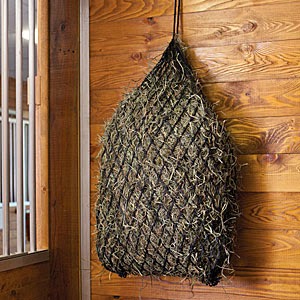My pasture was not established. Before we bought our farm, the pasture was an unmaintained field cut twice a year for low-quality hay (entirely for tax reasons, I believe). The first time I ever mowed it, the grass was over 4 feet tall. My horses moved in over the summer and in the general bustle of the first year, I did not do any pasture maintenance other than mowing and dragging (shame on me, I know).
Sample Pasture Maintenance Schedule
This was my pasture maintenance schedule during 2015:
- February: "Frost seed" 2 lbs of clover per acre using an Earthway hand-crank bag spreader. In retrospect, I didn't need to do this because the clover this year was more than plentiful. Still, frost seeding is a good tool to know about.
- Early March: Remove horses from pasture after thaw to allow it to rest and regrow. They stayed in the sacrifice area for a month.
- Mid-March: Collect a soil sample and send it to a lab.
- Late March: Fertilize according to the soil test results, in my case with 200 lbs of 20-10-10 per acre. I bought the fertilizer at a large agricultural and landscaping supply depot, and I spread it myself using a Brinly Hardy 175 lb tow-behind spreader. There was definitely a learning curve regarding how to set the spreader, but it did the job well.
- Early April: Overseed with a quality fescue blend, purchased directly from a seed company. The spreader came out again for this task. After spreading the seed, I dragged the pasture with a heavy chain harrow turned tines down, to rough up the surface and increase seed-soil contact.
- Mid April: Start reintroducing horses to grass, with small but increasing increments of turnout. At this point the grass was quite green and just needed to grow, which it did! After working up to full overnight turnout (16-17 hours a day), the horses stayed on this schedule until the fall.
- Early August: Lime according to the soil test results, in my case with a little over 1 ton per acre of agricultural lime. This I did not do myself because pelleted lime is very expensive, so I paid a local farmers coop to come out with their truck.
- September: Overseed areas where grass had gotten thin over the summer.
I had planned to fertilize in the fall as well, but we had almost no rain between July and October, and I was afraid to spread the granules then not be able to turn the horses out because there was nothing to dissolve them.
I also dragged and mowed the field as needed throughout the year. Keep in mind that I'm in the mid-Atlantic area and elsewhere your timing will be different.
I am no expert and I can't say this was the only way to manage my pasture, or even the best, but I hope it was a good first effort.
Pasture Management Resources
To educate myself on what needed to be done, I used many resources, including:
I also dragged and mowed the field as needed throughout the year. Keep in mind that I'm in the mid-Atlantic area and elsewhere your timing will be different.
I am no expert and I can't say this was the only way to manage my pasture, or even the best, but I hope it was a good first effort.
Pasture Management Resources
To educate myself on what needed to be done, I used many resources, including:
- Consultation with local farmers and land management experts, including my awesome arena builder who seems to know about everything to do with land and farm management.
- Visit by the local agricultural extension agent. This wasn't quite as helpful because he wasn't an equine expert and I already had a pretty good idea of what I wanted to do, but it's definitely something to keep in mind.
- The internet....yes, you could get lost in the web abyss, but there are a lot of good resources. Here are some links that I found useful enough to save for future reference:
- Basic overviews, from Fairfax County (VA) government: http://www.fairfaxcounty.gov/nvswcd/newsletter/horsepasture.htm and http://www.fairfaxcounty.gov/nvswcd/horse.htm
- Pasture and weed management hub from Penn State University, which includes detailed information on managing specific types of grasses and clovers (click on "Pasture Grasses and Forages" to find that): http://extension.psu.edu/animals/equine/pasture-weed-management
- Intro to fertilizing pastures, from the University of Minnesota: http://www.extension.umn.edu/agriculture/horse/docs/fact_sheet__fertilizing_horse_pastures_and_hayfields.pdf
- The basics of overseeding, including seeding rates, from the University of Kentucky: http://www.thehorse.com/articles/27812/recommendations-for-overseeding-horse-pastures
- The basics of frost seeding, including seeding rates, from Michigan State University: http://msue.anr.msu.edu/uploads/234/43269/Frost_Seeding_Guidelines.pdf
- A primer on dry lots from the University of Kentucky: http://www2.ca.uky.edu/agc/pubs/id/id171/id171.pdf
- Brief primer on rotational grazing with temporary cross-fences from the University of Kentucky: http://www2.ca.uky.edu/agc/pubs/id/id165/id165.pdf
- If you know of any good resources, please share it with the rest of us in a comment! I am always looking to learn more on the subject.























































